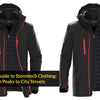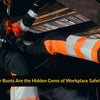When to Choose Non-Steel Safety Footwear: Benefits and Tips
- by Mike Johnson

When to Choose Non-Steel Safety Footwear
Safety footwear is an integral part of any job that requires the protection of feet from hazardous conditions. Non-steel safety footwear is a great alternative to steel-toe boots when the situation demands it. Non-steel safety footwear is lightweight, comfortable, and can provide great protection in many work environments.
It is important to know the benefits of non-steel safety footwear and when it is appropriate to choose this type of footwear over traditional steel-toe boots. Therefore, this article will discuss the benefits of non-steel safety footwear, as well as tips for choosing the right pair. With this information, you can make an informed decision as to when non-steel safety footwear is the best choice.
What is non-steel safety footwear?
Non-steel safety footwear is designed to protect the foot but does not contain steel toe caps. This type of footwear has many uses, such as on construction sites, in food processing plants, and in healthcare settings. Non-steel safety footwear is lightweight, comfortable, and can provide the same level of protection in many work environments.
Non-steel safety footwear is available in several styles, including full-grain leather, synthetic leather, fabric, and vinyl. Depending on the style of non-steel safety footwear, it may or may not have additional features, like puncture resistance, metatarsal protection, or a slip-resistant outsole. Each of these features can provide added protection to the wearer.
Benefits of non-steel safety footwear
Non-steel safety footwear offers many benefits over traditional steel-toe boots, including reduced weight and cost, along with the ability to wear a wider range of socks. However, when choosing non-steel safety footwear, it is important to look for added protection features. The following are some of the benefits of non-steel safety footwear:
Reduced weight and cost
Non-steel safety boots can be significantly lighter and less expensive than traditional steel-toe boots. Traditional steel-toe boots are typically made of heavier, more durable materials like leather or synthetic leather, whereas non-steel safety footwear can be made of lighter, less expensive materials like fabric or vinyl. Because non-steel safety footwear is lighter, it can make the wearer feel less fatigued, leading to improved comfort and productivity.
Wear a wider range of socks
Traditional steel-toe boots are built with a thicker insole and steel toe cap, which can make it hard to wear certain types of socks, such as those that are very thick or knee-high. Non-steel safety footwear is built with a thinner insole and no steel toe cap, which allows the wearer to wear a wider range of socks with the footwear. This can be beneficial in many work environments, as it can help keep you warm in the colder months and protect your feet from abrasion in dusty, dirty industries.
When to choose non-steel safety footwear
There are many situations where non-steel safety footwear is the best choice. The following are some examples of when non-steel safety footwear is the appropriate choice:
Where there is a hazard of falling objects
When you work in an environment with a hazard of falling objects, you need footwear with a metatarsal guard to protect your toes from injury. Non-steel safety footwear meets this requirement, whereas traditional steel-toe boots do not.
When you are on your feet for long periods of time
If you spend long hours on your feet, it is important to choose non-steel safety footwear. Traditional steel-toe boots can be heavy and stiff, which can make long hours of standing or walking uncomfortable. Non-steel safety boots can be lighter and more flexible, which can improve comfort for long periods of time.
You need maximum comfort.
If you need to do an activity that involves a lot of walking or you need to stand for long periods of time, non-steel safety footwear can be a great choice. Traditional steel-toe boots can be heavier and stiffer than non-steel safety footwear, which can make long periods of walking or standing more uncomfortable.
Tips for choosing the right pair of non-steel safety footwear
When choosing non-steel safety footwear, there are several things to keep in mind. The following are some tips for choosing the right pair of non-steel safety footwear:
Choose a style that meets your needs.
When choosing non-steel safety footwear, consider the type of work you will be doing. Certain styles of non-steel safety footwear offer added protection, such as a metatarsal guard or puncture resistance.
Choose a style that you like
It is important to choose non-steel safety footwear that you like and are comfortable wearing. If you do not like wearing footwear, you are less likely to wear it as often as you should, which can reduce the level of protection it provides.
Choose a pair that fits well.
It is important to choose a pair of non-steel safety footwear that fits well. Non-steel safety footwear should fit comfortably but not too tightly. If you choose footwear that is too large, you are less likely to wear it.
Common hazards and the appropriate footwear
The hazards you face on the job can help you decide which non-steel safety footwear to choose. The following table highlights the appropriate footwear for specific hazards: If you face a combination of hazards, you may need to choose footwear that provides more protection.
Proper care and maintenance of non-steel safety footwear
Like steel-toe boots, non-steel safety footwear needs to be kept clean and properly maintained. The following are a few tips for proper care and maintenance of non-steel safety footwear: -
Always clean your footwear after use.
It is important to clean your footwear after each day of work. Even if you are wearing non-steel safety footwear, dirt and debris can get inside the footwear and lead to foot abrasion and infection.
Check your footwear regularly.
It is important to check your footwear regularly for signs of wear and tear. If your footwear is showing signs of wear and tear, such as a hole or tear in the sole, it is time to replace the footwear. -
Choose a cleaner that is made for your footwear.
After you clean your footwear, it is important to choose a cleaner that is made for the type of material that your non-steel safety footwear is made of. Doing so will help keep your footwear in good condition longer.
Conclusion
Safety footwear is an important part of any job. Steel-toe boots are one type of safety footwear, but another type is non-steel safety footwear. Non-steel safety footwear can provide the same level of protection as steel-toe boots, but it is lighter and more comfortable to wear. When choosing non-steel safety footwear, it is important to keep in mind the hazards of your job, as well as the appropriate footwear. It is also important to follow the proper care and maintenance of non-steel safety footwear to help extend the life of your footwear.





